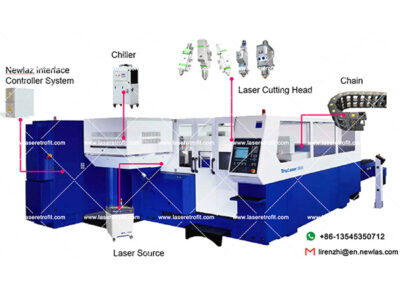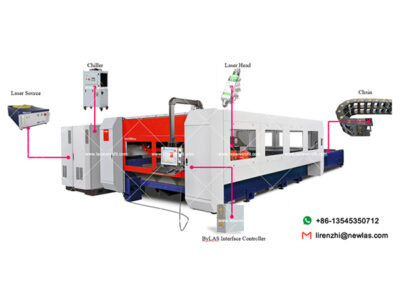As technology improves over time, we are conditioned to expect the latest and greatest laser is always better than what we have in the past.
Manufactures are working hard to develop higher wattage machines to increase production. As a guy it’s hard to make this next statement: Power isn’t everything. Power requirements are really dependent on what type of material you process.
For an example, mild steel melts between 2500-2800 degrees F, depending on the percentage of carbon, manganese or silicon elements present in the material. So, how do we get our watts and temperature together so that we can compare just how much power we really need to process mild steel? Watts is a measure of power and Fahrenheit is a measure of temperature. To make a long calculation short, a 1kW focused beam is equal to approximately 8 million watts per centimeter squared, and steel vaporizes at 2 million watts per centimeter squared.
This brings up the next question, once you melt steel, how much more power do you really need? That depends on several things, such as what type of assist gases are you using for cutting.
Oxygen cutting
When oxygen is used as the cutting gas, it’s blown through the kerf at a pressure between eight to 60 PSI depending on material thickness. The oxygen interacts with the molten metal and begins to burn and oxidize it.
This reaction can increase the laser’s energy by up to five times while expelling molten material from the kerf. Once the material melts and expels, we need to move the drive system forward and continue the heating and expelling until we reach the maximum feed rate that is determined by the heat saturation point for that material thickness.
Nitrogen cutting
When nitrogen is used as the cutting gas, it’s blown through the kerf at a pressure between 30 to 300 PSI depending on material thickness. Nitrogen is an inert gas, so it doesn’t react with the molten metal in the kerf like oxygen. The gas is used specifically to expel molten material from the kerf and simultaneously shield the cut edge from the air giving it an oxide free edge. As an added benefit, the material is cooled by the inert gas and along with the focused laser-beam spot size of 0.004 in. to 0.007 in. prevents thermal runaway into the material, which keeps the material molecular structure consistent allowing an increase in cut speed.
However, the laser beam must supply all of the power needed for cutting, as the nitrogen doesn’t supply any extra energy like oxygen. On thin material, we can break the melting point barrier restrictions and achieve higher cut speeds with the additional cost of the nitrogen gas.
I know I still haven’t answered the question; how much power do I need?
Let’s start with a basic example of a part and cut it using different power levels and with different types of lasers.
0.060” Mild Steel Manufacture recommended Part Cycle Time
Cut Feed rates
2kW Ball screw Laser 250 IPM cut with oxygen 87 seconds
2kW Linear Drive Laser 250 IPM cut with oxygen 60 seconds
2.5kW Linear Drive Laser 375 IPM Cut with nitrogen 33 seconds
5kW Linear Drive Laser 375 IPM Cut with nitrogen 33 seconds
5kW Linear Drive Laser from another manufactures resonator 340 IPM Cut with nitrogen 44 seconds
From the first two examples you can see that the power level and cut feed rate speed had no effect on the difference in cycle time. The ball screw versus linear drive machine was really the deciding factor. How fast a machine can accelerate and decelerate from the start of the cut through corners or from feature to feature has a tremendous impact on the final part-cycle time. Then once we compare 2000 watts versus 2500 watts with the same drive system, our cycle time is almost cut in half.
However when we compare that to a 5000 watt laser, we see no gain at all. At 2500 watts we were able to break the barrier and use nitrogen as the assist gas giving us the extra speed we desired. But even with more power, we hit yet another speed limit. Remember from our last article we stated, not all laser beams are created equally, and they don’t perform equally.
A laser’s beam quality is specified as M2. M2=1 indicates the laser beam is diffraction limited and capable of being focused to its smallest theoretical spot size. M2=1 is the holy grail of beam quality. A higher M2 number usually requires higher average power to accomplish the same processing capabilities as a lower M2 number. I then compared the mode quality from a laser with laser beam mode quality of M2=1 to a M2=3 laser resonator with the same drive system and same power level, and we see yet another cycle time difference. Remember power is not everything. How fast we pierce material, accelerate, decelerate, and how fast the scan time is on a computer driving the laser all comes in to play for the final cycle time of a part.
There are reasons why we need more power from a laser. One is to cut heavier material thickness in mild steel. Aluminum and stainless steel all require more power because of their reflective natures.
As a laser’s power level goes up, there’s an additional initial purchase price difference along with the cost burden to maintain it. Also, there will be a difference in the daily cost of consumables, along with additional costs for optics that will be damaged from power induced stress from a higher kilowatt laser.
Ultimately you need to decide what materials you will process most, and what the additional costs will be to have all the power that you could possibly ever use at your disposal.
Look at it this way; if the speed limit is 55 MPH and you have a car capable of 200 MPH, did you make a good purchase?
Cr: Todd Jacobson, Laser Maintenance Group Corp






